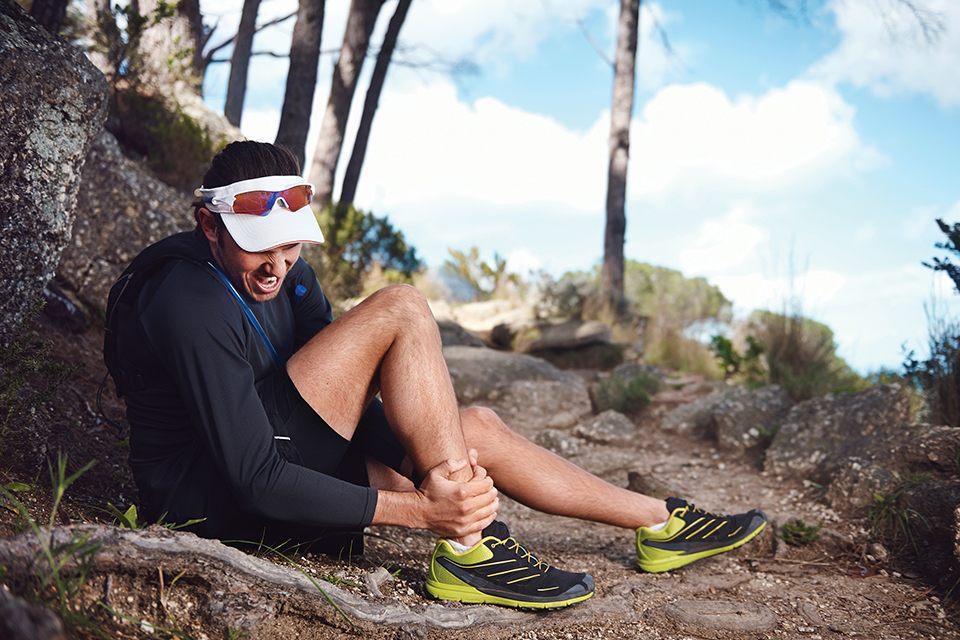Ankle Injury Action

Lying on your back now looking up at the clear blue sky, you begin to reflect on the circumstances that brought you here. First, there was the well-intended leap over the downed tree lying across the trail. Then, there was the unintended landing on the small boulder, the less than graceful mid-air spin, and finally the immodest collapse onto hard ground. Somewhere in the middle of this was the unambiguous snap in your ankle. You have time to review these events in surprising detail before the adrenaline rush gives way to searing pain—and the realization that you are miles from help.
A precarious situation like this requires clarity of thought and deliberate action in order to prevent further injury. Too often, as athletes, the urge to get up and start moving after an injury is immediate and irrepressible, as though we want to see how much dysfunction we may have just incurred. I’m going to discourage you from this—instead, employ the temperance of cautious assessment.
First take an inventory of yourself and your surroundings. Ask yourself the following questions:
1. Am I safe where I am? Did you fall on an ant hill, in an avalanche zone, or in the path of a stampeding longhorn? So long as you’re not in any immediate danger, you are probably better off staying put until you can answer the next question.
2. Can I feel and move everything? You can make a necessary exception for the affected ankle for now; however, if you feel numbness or tingling somewhere else, or are unable to use other body parts, you may have a more serious problem and should try and stay put until help arrives.
3. Can I move the ankle? That snap you felt could have been a bone breaking, or a tendon snapping, or a joint dislocating. In the latter case, the shape of the thing and the complete inability to use it will tell the story. Between the fracture versus the sprain or strain, however, it can be hard to tell. No need to fret over the difference, the sprain can take longer to heal from than the fracture anyhow. If you feel what seems like bones grinding together, however, you are more likely to cause further injury by any unnecessary movement. The prescription in this case is again to stay put.
Try to summon help. If you have a cell phone, a whistle, or a smoke grenade, now may be a time to use it. If you are on the Austin greenbelt, just wait and someone will likely come by. If, on the other hand, you are in a more remote location, you may need to consider moving somewhere, and will want to stabilize your injury while you consider your options. Only move as a last resort.
In 1985, two climbers were descending an extremely remote mountain in South America when one of them shattered his tibia (lower leg bone). They were separated when the same climber fell into a crevasse, and had no possibility of rescue. To make one of the greatest personal survival stories in modern mountaineering history very short, let’s just say that he crawled out—through crevasses and talus fields—in a snowstorm. It took him three days.
Attempt to create some kind of splint. Almost anything with rigidity and flexibility will do. The climber mentioned above eventually wrapped his sleeping pad around his lower leg. Once, when I was a ski-patroller, I saw a woman come into the patrol room with a broken wrist. Her boyfriend had splinted it using a curled up phone book and her ski parka as padding. If you are running or hiking in truly remote areas, then you should carry something with you (not a phone book). Lots of camping materials work well, including ensolite pads and internal frame backpacks.
If the foot downstream—or distal, as we call it in medicine—is turning pale, or you cannot feel it, this could be a sign of absent or impaired circulation. If this occurred after you applied the splint, then loosen it. If it was present before the splint, then you may have a pinched or a ruptured blood vessel, and you need to get to a hospital as soon as possible.
Taking short cuts on the trail is one thing, but don’t let unexpected tragedy cause you to make shortcuts in your decision making. Consider each move carefully and your path to recovery will be a safe one.







